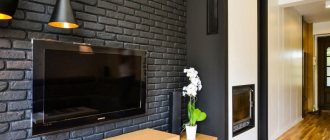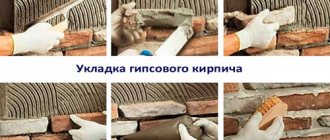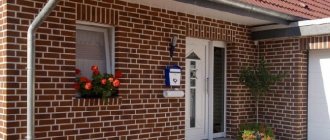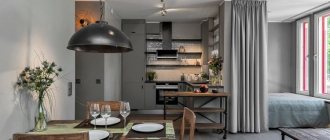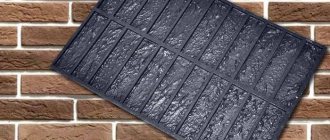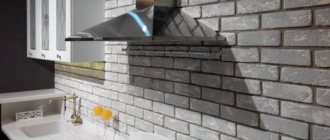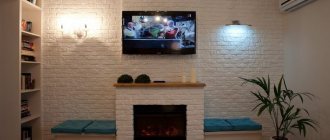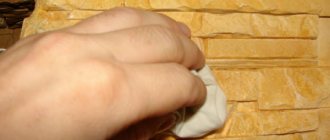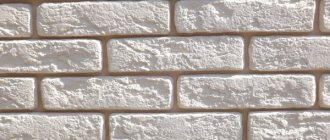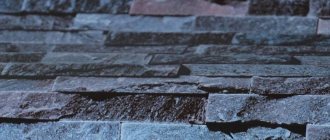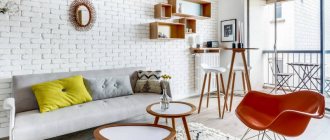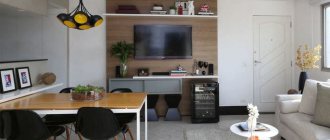Nowadays, brick is rightfully considered the most popular building material. Therefore, a brick wall in an apartment is also in particular demand among property owners.
Decorative brick-like coating - a wide choice from purchased materials to DIY.
Interior designers have been using current compositions in this type of decoration for a long period of time, for example, unique designs, a palette of shades. Such elements create an exclusive design of the room. This imitation is ideal for various styles and decor concepts.
Finishing a wall with brick is a very creative solution.
Basic rules for decorating brick walls in an apartment
The main principles of using brickwork in interior design are very simple. Experts say that brick complements the design with beauty and comfort, but only if it is used in optimal quantities. If you ignore such advice, the living space will become cold, devoid of home comfort.
Sometimes this finishing protects the surface from the influence of moisture and other factors.
Basic rules for designing a decorative brick wall in an apartment:
- you should highlight the surface that is optimal for transforming the room - an accent wall;
Brick wall decoration is applicable almost everywhere: offices, cafes, cottages, private houses and apartments.
- you can decorate with this building material or create an imitation of various architectural elements, for example, arches, windows, partitions, columns, decorative recesses;
The size of the room does not matter, because the choice of material for such finishing is large - from painting to using tiles.
- A great highlight is to focus on the fireplace area in the living room.
These materials are light in weight, so when decorating the surface, it will not be weighed down by finishing material.
Brickwork can become an impeccable backdrop for paintings and photographs. To create the right atmosphere, it is recommended to pay special attention to the selection of harmonious colors and artistic concepts.
Decorative brick on the wall has not lost its relevance.
Interesting! An ideal example is wall decor with white brick with a spectacular addition. These elements can be bright and cheerful colors used in some surface areas. This option will be a wonderful change from the Scandinavian design concept. It combines tranquility and expressive notes at the same time.
To implement this bold idea, you will need an imitation decorative finishing material.
How to lay it correctly
Laying decorative bricks with your own hands should not cause any particular difficulties; this requires a special adhesive composition and properly growing hands. However, you should still be aware of some nuances:
- The surface that needs to be decorated must be carefully prepared: leveled, puttied if necessary and primed. If you lay bricks on a crooked base, then the result will be crooked, because due to the small thickness, the elements cannot hide such defects and will repeat all the flaws.
- To obtain an even ornament, a building level is used; the bottom layer is always laid out first.
- Before installation, it is necessary to dilute a special adhesive according to the instructions. You should not experiment and use products that are not intended, as the result can be very unpredictable, from poor fixation to a change in the color of the bricks. Depending on the type of product, the composition is applied either to the wall or to the bricks themselves using a notched trowel.
- If you plan to combine several colors to form a pattern, then all the components must first be laid out on the floor. This way you won’t have to urgently change anything on the wall in case of inconsistencies.
- To form the corners, the elements will have to be cut. Gypsum brick is easily cut with a regular hacksaw. To cut ceramic you will need special tools.
- Before starting to process the seams, you need to let the adhesive solution dry. This usually happens within a day, but it is better to carefully study the instructions for the glue.
If the seams are not planned to be “sewn up”, and the installation was done using a notched trowel, then at the time of installation it is better to wipe the seams with a brush so that unsightly striped marks do not remain.
Pros and cons of imitation brick walls in an apartment
Decorative brick for walls in an apartment is, first of all, beautiful and fashionable. Among the advantages of the material are:
- small mass. It will not increase the load on the overall structure of the building;
- ease of care;
- resistance to mechanical stress;
- high degree of strength;
- if necessary, property owners can update only part of the surface;
- an extensive pricing policy, so every consumer will find their product from a category acceptable to them, this is an undeniable plus in our time.
In such an interior it will look out of place in any room.
The downside is the fragility of the decorative material. Therefore, before you make a brick wall in your own apartment, you will need to make sure that you can handle it with care during the laying process.
The color of the masonry can correspond to the taste preferences of the owners.
Decorative plaster
Repair using plaster mixtures is suitable when it is important not to overload the walls. The surface is durable, resistant to mechanical and environmental influences. If you want to change the decor, you can do this by painting the wall a different color. In this case, the invoice will be saved. If you want to get a flat surface or change the relief, you will have to knock down the plaster.
Work can be performed at temperatures from +10 degrees and above. Since the relief texture predisposes to the accumulation of dust in the depressions, you will have to wipe the wall more often. Otherwise, it does not require any special care.
Brick imitation can be performed using compositions with different bases. For example, to obtain a white surface, you can use gypsum . If the relief texture is important, you can take a product made from acrylic putty with sand . The mixture should adhere well to the base and have setting conditions suitable for creating texture. In construction stores you can find products with silicate or silicone components . Mixing formulations with different types of base is unacceptable. The color change can be done by tinting the product before applying or painting the finished textured surface. Recommendations for this part are given on the packaging of the composition.
Finishing technology
The plaster is applied to a previously leveled wall - minor defects are repaired with putty, and in case of serious differences, corrections are made using beacons. A texture can be created in different ways. The most common of them are applying an impression and forming a seam with a pointed object . In this case, the mixture is applied to an area that can be treated before drying, and immediately after that the treatment is carried out using the selected method. Then they move on to the next section.
There are also complex methods practiced by experienced craftsmen. For example, to form rustications on plaster, markings are made and a metal strip 0.5-1.5 cm thick is placed on the line. By hitting with a mallet, the device is pressed into the surface. Then the rail is carefully removed. The surfaces of the resulting large bricks are given the texture of stone. This must be done before the layer dries.
Types of materials for simulating brick in an apartment
The market offers a wide range of different elements for decorating a room. Therefore, it is very important to choose the right components that will bring the desired result. Let's look at the most popular types of brick finishing in an apartment.
In such an interior, a white brick wall will fit better into the style.
Gypsum tiles
Refers to the most budget options. Most often used to decorate corridors and hallways. Plaster can become deformed due to high humidity. You will definitely need to coat the surface with a water-repellent varnish.
Gypsum brick tiles are absolutely environmentally friendly and allow the surface to breathe.
Cement wall tiles
Made from sand and clay by hand. Very similar to natural brick, despite its fragility. The surface of the components is distinguished by relief and roughness. Such tiles are completely environmentally friendly, therefore they are considered a good method for wall cladding.
Cement tiles have excellent performance characteristics and can be used for decorative cladding in rooms operating at any temperature.
Clinker tiles
It creates a flawless imitation of brickwork. These tiles are smaller in size than standard material, but their price is a little more expensive. It is characterized by density, strength, increased performance characteristics, and a variety of colors.
Clinker tiles have minimal porosity, excellent strength, excellent thermal insulation, frost-resistant, moisture-resistant and decorative characteristics.
PVC and MDF panels
MDF and PVC are considered the most popular and reliable methods of decoration today. They are resistant to external factors, do not require careful maintenance, and are not expensive. In some cases, before laying, you will need to install an additional structure that can take up some usable space.
This material is easy to use, and its protective coating can withstand moderate impacts and friction.
Brick wallpaper
This material is ideal for owners who do not want a pronounced masonry texture. This wallpaper can be used to cover part of the surface in one room or several fragments in an apartment.
There are many variations of shades on the market, which will allow you to create a unique interior design.
Glass fiber reinforced concrete panels
Building panels today are considered leaders in creating imitation brickwork. They are durable, waterproof, and resistant to alkali and acid.
Bars and restaurants widely use them to create authentic interiors.
Use of building panels
Construction panels are the leader among decor options. They are durable and moisture resistant. The material has long been in demand in the exterior finishing market, and is now also used in interior spaces. The material for the production of imitation panels is plastic. He is not afraid of dust, moisture, mold, rust. The panels are resistant to alkalis, acids, and hot drops of fat , so they are often used to furnish a kitchen space.
Advantages of building panels:
- ease of fastening;
- light weight;
- soundproofing;
- attractive appearance;
- acceptable cost.
One of the disadvantages is that some panels require additional sheathing, so the structure takes up some of the usable space. The panels are attached horizontally and vertically, and the pattern depends on the location option. Installation is carried out using nails, screws, self-tapping screws, often directly on the wall. Each element is fixed independently. The damaged part of the finish can be replaced quickly . Panels are a suitable option for decorating a balcony, kitchen apron, or corridor.
Popular colors of imitation brickwork in an apartment
Nowadays, the building materials market offers bricks for partitions in apartments in various shades. This coating allows you to select components for decoration taking into account personal preferences, design concepts and other important factors.
It’s easier and faster to make brick decor from soft tiles or using wall panels.
Red
This clay, which is part of classic bricks, dictates its own rules in assigning tone. The red wall stands out from the rest of the surfaces.
It will become the main highlight in the apartment.
White
This palette is ideal for any size room. Glossy plaster will visually enlarge the living space and add freshness. Therefore, using brickwork in this shade is considered the most popular today.
It will complement all design concepts with its visual lightness.
Brown
This color is considered more traditional for natural ingredients. It will become a luxurious addition to modern, loft, and high-tech styles. Choosing furniture for such an interior is as easy as shelling pears.
The main thing is to avoid excessive use of a dark palette, otherwise the room will lose its comfort.
Wallpaper
The method is suitable for those who want to imitate a brick wall quickly, but do not pay attention to the volume of the texture. To achieve maximum realism, choose vinyl or non-woven fabrics: all the cracks and folds are visible on them, and the “brick” itself is slightly convex. Paper wallpaper has a less clear pattern and does not last as long, but is cheaper.
Another option is high-quality photo wallpaper, but their price is equal to the cost of gypsum tiles.
Tips and recommendations from professionals when organizing a brick interior
Brick for finishing walls in your own apartment is a popular material nowadays. Experts advise following these recommendations:
- the main requirement for imitation brickwork is believability;
- follow the principles of proper care of decorative panels;
- this method of decoration can bring uniqueness to the bathroom;
The bathroom needs moisture-resistant material with a surface that is easy to clean.
- white finishing plaster allows you to create the image of masonry, but with a smooth surface;
- give preference to the shade of the material that should dominate the room;
- be sure to make sure there is enough light.
Due to some complexity of installation, in some cases it is better to invite a professional.
Any method of decoration looks unusual, stylish and impeccable. Property owners will be able to feel like residents of the Middle Ages.
The vintage look of the brickwork will add variety and exclusivity to the living space.
Features of plastering external walls
The difference between performing external work is the same:
- the entire surface must be reinforced with metal mesh;
- when plastering external facades, it is recommended to use a cement-sand mixture;
- the corners of the building and slopes are fixed with special perforated plastic corners (their unique reinforcement is performed);
- total permissible thickness of the applied plaster layer ≤ 15 mm;
- Before covering, the previous layer is primed twice.
For other positions, the technology for carrying out work from the outside and inside is the same.
What is the best way to plaster external facades?
Exterior finishing is carried out only with DSP or cement-lime mixtures. In areas of efflorescence, sanitizing mixtures are used. Finishing may involve the use of decorative plaster, both universal and purely facade. Plinths are plastered only with DSP.
Brick finishing in an apartment - 50 design options:
Gypsum products
Gypsum panels that look like brick look especially good in the interior; they most accurately convey the texture of this material, so such an imitation is practically indistinguishable from a real brick wall. Another advantage of gypsum products is absolute fire safety.
USEFUL INFORMATION: Decorative plates in the kitchen interior: how to decorate the wall above the dining table
However, it should be remembered that gypsum is afraid of moisture, so this finish is only suitable for dry rooms.
Another feature of gypsum boards is their fairly considerable weight. So, for example, a 50 × 50 × 3 cm slab weighs 4 kg.
